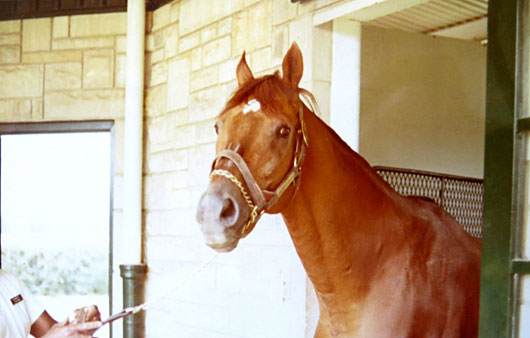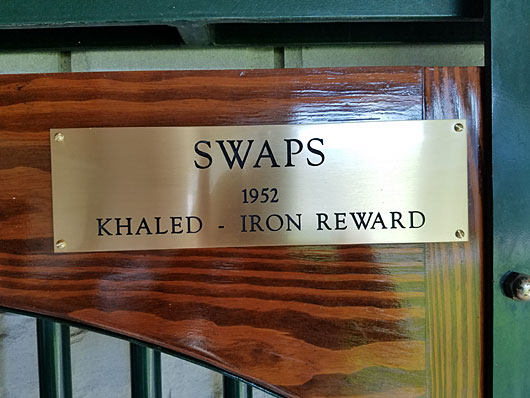Unlike children who fall in love with horses at an early age, it took me 20 years to discover my love of horses and horse racing and embark on the path I was destined to take.
Growing up in Brooklyn in the ‘50s and early ‘60s meant sports of all kinds, mostly baseball and my beloved Dodgers and the hallowed ground known as Ebbetts Field. And there were those glorious pro football years following the New York Giants and watching them lose the championship game every year to the Colts, Packers, and then Bears. And there were those Wednesday and Sunday nights taking the subway into Manhattan with my buddies to see the New York Rangers entertain only five other teams in the old Madison Square Garden. Finally, there was joining the members of our family circle in our usual first row seats under the basket at the Garden watching the Knicks.
That was the extent of sports to me in the ‘50s. But one day I was on a bus and overheard two people mention the names Swaps and Nashua. Even as a non-racing fan, I had heard of these two Thoroughbreds. There was something almost melodic about the their names strung together that seemed to fit as neatly as Lucy and Ricky and Abbott and Costello. I never paid much attention to them after that day, only seeing and hearing their names on occasion.
Little by little the names of Thoroughbreds would catch my attention, names like Tim Tam, Sword Dancer, Carry Back, Kelso and Chateaugay. It seemed like the name Kelso was in some headline in the New York Daily News almost every week.
One of my favorite games back in the late ‘50s was my little horse racing board game that had about six horse figures, each with a different name with a matching color. I remember Citation, Whirlaway, Twenty Grand, Gallant Fox, and I’m not sure of the others. You would spin the arrow and whichever horse came up you would move up a space. It was totally mindless, but I kept thinking it was fixed because Citation seemed to win almost every time.
This was the extent of my racing foundation, and it all started with Swaps and Nashua and two guys talking about them on a bus. After all, how could you not love the name Swaps?
I am going to fast forward to this past August and our visit to Spendthrift Farm. There are few barns in the Bluegrass more historic than the U-shaped Spendthrift stallion barn, with its outdoor stalls and all the stallions easily visable. The names of the great Thoroughbreds who have resided here read like a Who’s Who of racing. But the farm, which used to be owned by Leslie Combs and then his son Brownell, began to offer stock to the public in 1983 during the inflation boom. Unfortunately, the collapse of the Thoroughbred breeding market resulted in a number of lawsuits against the farm, and with a continued decline of the market, Spendthrift was forced to declare bankruptcy. The farm remained silent for years until it was purchased in 2004 by storage company magnate B. Wayne Hughes, who has turned it back into one of the most successful stallion operations in the country.
But the history still lives and breathes at Spendthrift. In the breeding shed, above the stalls, going all the way up to the ceiling, are the names of every stakes winner conceived at the farm, and the year they won a stakes, with some names appearing multiple times. In all, there has to be well over a thousands names. In the older wooden stallion barn are larger plaques depicting the names of the classic winners and champions that stood at Spendthrift at some point in their stud career.
And then there are the nameplates on the top of the stall doors in the main stallion barn of the stallions that resided in that stall. Just like at Claiborne Farm, you can see in which stalls all the great stallions lived.
There on shiny nameplates are legendary names such as Nashua, Raise A Native, Affirmed, Seattle Slew, Gallant Man, Exclusive Native, Majestic Prince, Sham, and Foolish Pleasure.
But there was one name missing. Where was the nameplate for Swaps, who stood at Spendthrift for a number of years after coming there from Darby Dan Farm?
Ned Toffey, general manager of Spendthrift, who was giving Joan and I the royal tour, admitted that Swaps’ name was missing because no one knew in which stall he resided.
When I heard that I lit up like the proverbial Christmas tree. I had visited Spendthrift back in 1972, and all the stallions were brought out except one. I was told that Swaps was not doing well physically and his appearance prevented them from showing him to visitors. I saw all the stallions, including Nashua, whose longtime groom, Clem Brooks, dubbed the stallion barn the Nashua Motel, as evidenced by the statue of Nashua and Brooks outside the barn. Here were those two rivals from 1955 residing in the same barn. I was dismayed, however, to hear that Swaps was doing so poorly.
Here was a horse who, from film clips and photographs, was one of the grandest, most breathtaking Thoroughbreds you will ever see; a horse who not only set world records up to a mile and five-eighths, he broke nine track records and equaled another, with seven of those track records coming as a 4-year-old, six of them carrying 130 pounds. I remember many years ago my good friend Floyd Williams, who was the stud groom at Darby Dan Farm, telling me that that he was working at Arlington Park at the time of the much-publicized match race between Swaps and Nashua. Swaps was stabled in his barn and he said the colt had a hole in his foot the size of a quarter. But there was too much at stake and too much pre-race hype to scratch him. Swaps' final career victory came in the Washington Park Handicap in which he ran the mile in 1:33 2/5, missing his own world record by a fifth of a second. Swaps truly was one of the great ones, and to hear that he was so bad off they didn’t want to take him out for visitors really saddened me.
Because the stallion barn is open, I was able to see Swaps’ head sticking out, as if he were wondering why he wasn’t brought out with the other stallions. The groom went over and opened the screen, allowing Swaps to step forward almost out the door. I walked up to him and spent several minutes looking into his eyes and picturing him tearing up the Hollywood Park track at 4 and the year before defeating the king of the East, Nashua, in the Kentucky Derby. It was a special moment, seeing a legendary horse whose name, along with Nashua, was the first Thoroughbred I ever heard mentioned back when I was 8 years old. I took one photo of him and left, hoping one day he would be doing well enough physically to be brought out for visitors to see.
But a few months later, on November 3, 1972, Swaps was euthanized at the age of 20. He was buried at Spendthrift Farm, but in 1986 his remains were moved to the Kentucky Derby Museum at Churchill Downs. I was just thankful I was able to see him once before he died.
When Ned told me they didn’t know in which stall Swaps resided and were unable to put up a nameplate for him I was thrilled to point out his stall. I remembered it vividly because it was a corner stall. When I returned home, I was able to dig up that one photo I took of him 45 years earlier. I photographed it and put the memory card on my laptop and sent it to Ned. He immediately put in an order for Swaps’ nameplate to be made up, and it is now atop the stall for all to see. The legacy of Spendthrift’s great stallion roster is complete. The grand name of Swaps has finally found its home.

My one and only shot of Swaps taken shortly before his death. It still makes me sad whenever I look at it

Swaps finally has his nameplate, and his stall is now known after more than four decades




